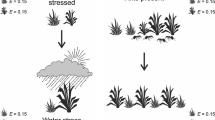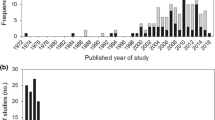Abstract
The theoretical underpinnings of the assessment of invasive alien species impacts need to be improved. At present most approaches are unreliable to quantify impact at regional scales and do not allow for comparison of different invasive species. There are four basic problems that need to be addressed: (1) Some impacted ecosystem traits are spatially not additive; (2) invader effects may increase non-linearly with abundance or there may be effect thresholds impairing estimates of linear impact models; (3) the abundance and impact of alien species will often co-vary with environmental variation; and (4) the total invaded range is an inappropriate measure for quantifying regional impact because the habitat area available for invasion can vary markedly among invasive species. Mathematical models and empirical data using an invasive alien plant species (Heracleum mantegazzianum) indicate that ignoring these issues leads to impact estimates almost an order of magnitude from the real values. Thus, we propose a habitat-sensitive formula for regional impact assessment that is unaffected by non-linearity. Furthermore, we make some statistical suggestions on how to assess invader effects properly and we discuss the quantification of the invaded range. These improvements are crucial for impact assessment with the overall aim of prioritizing management of invasive species.




Similar content being viewed by others
References
Aizen MA, Morales CL, Morales JM (2008) Invasive mutualists erode native pollination webs. PLoS Biology. doi: 10.1371/journal.pbio.0060031
Byers JE (2002) Physical habitat attribute mediates biotic resistance to non-indigenous species invasion. Oecologia 130:146–156
Byers JE, Reichard S, Randall JM, Parker IM, Smith CS, Lonsdale WM, Atkinson IAE, Seastedt TR, Williamson M, Chornesky E, Hayes D (2002) Directing research to reduce the impacts of nonindigenous species. Conserv Biol 16:630–640
Callaway RM, Ridenour WM (2004) Novel weapons: invasive success and the evolution of increased competitive ability. Front Ecol Environ 2:436–443
Chytrý M, Jarošík V, Pyšek P, Hájek O, Knollová I, Tichý L, Danihelka J (2008) Separating habitat invasibility by alien plants from the actual level of invasion. Ecology 89:1541–1553
Colautti RI, Bailey SA, van Overdijk CDA, Amundsen K, McIsaac HJ (2006) Characterised and projected costs of non-indigenous species in Canada. Biol Invasions 8:45–59
Cook DC, Thomas MB, Cunningham SA, Anderson DL, De Barro DJ (2007) Predicting the economic impact of an invasive species on an ecosystem service. Ecol Appl 17:1832–1840
Crooks JA (2002) Characterizing ecosystem-level consequences of biological invasions: the role of ecosystem engineers. Oikos 97:153–166
Davis MA, Thompson K (2000) Eight ways to be a colonizer; two ways to be an invader: a proposed nomenclature for invasion ecology. ESA Bull 81:226–230
Gaston KJ (2003) The structure and dynamics of geographic ranges. Oxford University Press, Oxford
Gómez-Aparicio L, Canham CD (2008) Neighborhood models of the effects of invasive tree species on ecosystem processes. Ecol Monogr 78:69–86
Griffen BD, Byers JE (2006) Partitioning mechanisms of predator interference in different habitats. Oecologia 146:608–614
Hacker SD, Dethier MN (2006) Community modification by a grass invader has differing impacts for marine habitats. Oikos 113:279–286
Hiebert R (1997) Prioritizing invasive plants and planning for management. In: Luken JO, Thieret JW (eds) Assessment and management of plant invasions. Springer, New York, pp 195–212
Hüls J, Otte A, Eckstein RL (2007) Population life-cycle and stand structure in dense and open stands of the introduced tall herb Heracleum mantegazzianum. Biol Invasions 9:799–811
Isermann M (2008) Effects of Rosa rugosa invasion in different coastal dune vegetation types. In: Tokarska-Guzik B, Brock JH, Brundu G, Child L, Daehler CC, Pyšek P (eds) Plant invasions: human perception, ecological impacts and management. Backhuys Publishers, Leiden, pp 289–306
Johnson NL, Kotz S, Balakrishnan N (1994) Continuous univariate distributions, 2nd edn. Wiley, New York
Juliá R, Holland DW, Guenther J (2007) Assessing the economic impact of invasive species: the case of yellow starthistle (Centaurea solstitialis L.) in the rangelands of Idaho, USA. J Environ Manage 85:876–882
Larson DL, Royer RA, Royer MR (2006) Insect visitation and pollen deposition in an invaded prairie plant community. Biol Conserv 130:148–159
Lopezaraiza-Mikel ME, Hayes RB, Whalley MR, Memmot J (2007) The impact of an alien plant on a native plant-pollinator network: an experimental approach. Ecol Lett 10:539–550
Mack MC, D’Antonio CM (1998) Impacts of biological invasions on disturbance regimes. Trends Ecol Evol 13:195–198
Mack RN, Simberloff D, Lonsdale WM, Evans H, Clout M, Bazzaz FA (2000) Biotic invasions: causes, epidemiology, global consequences and control. Ecol Appl 10:689–710
Mason TJ, French K, Russell KG (2007) Moderate impacts of plant invasion and management regimes in coastal hind dune seed banks. Biol Conserv 134:428–439
McNeely JA, Mooney HA, Neville LE, Schei P, Waage JK (2001) Global strategy on invasive alien species. IUCN on behalf of the Global Invasive Species Programme, Gland
Meiners SJ, Pickett STA, Cadenasso ML (2001) Effects of plant invasions on the species richness of abandoned agricultural land. Ecography 24:633–644
Nielsen C, Heimes C, Kollmann J (2008) Little evidence for negative effects of an invasive alien plant on pollinator services. Biol Invasions 10:1353–1363
Parker IM, Simberloff D, Lonsdale WM, Goodell K, Wonham M, Kareiva PM, Williamson MH, Von Holle B, Moyle PB, Byers JE, Goldwasser L (1999) Impact: toward a framework for understanding the ecological effects of invaders. Biol Invasions 1:3–19
Pimentel D, McNair S, Janecka J, Wightman J, Simmonds C, O’Connell C, Wong E, Russel L, Zern J, Aquino T, Tsomondo T (2001) Economic and environmental threats of alien plant, animal, and microbe invasions. Agric Ecosyst Environ 84:1–20
Pyšek P, Pyšek A (1995) Invasion by Heracleum mantegazzianum in different habitats in the Czech Republic. J Veg Sci 6:711–718
Pyšek P, Cock MJW, Nentwig W, Ravn HP (eds) (2007) Ecology and management of Giant Hogweed (Heracleum mantegazzianum). CAB International, Wallingford
Reaser JK, Meyerson LA, Cronk Q, De Poorter M, Eldrege LG, Green E, Kairo M, Latasi P, Mack RN, Mauremootoo J, O’Dowd D, Orapa W, Sastroutomo S, Saunders A, Shine C, Thrainsson S, Vaiutu L (2007) Ecological and socioeconomic impacts of invasive alien species in island ecosystems. Environ Conserv 34:98–111
Richardson DM, van Wilgen BW (2004) Invasive alien plants in South Africa: how well do we understand the ecological impacts? S Afr J Sci 100:45–52
Rinella MJ, Luschei EC (2007) Hierarchical Bayesian methods estimate invasive weed impacts at pertinent spatial scales. Biol Invasions 9:545–558
Thiele J, Otte A (2006) Analysis of habitats and communities invaded by Heracleum mantegazzianum Somm. et Lev. (Giant Hogweed) in Germany. Phytocoenologia 36:281–320
Thiele J, Otte A (2007) Impact of Heracleum mantegazzianum on invaded vegetation and human activities. In: Pyšek P, Cock MJW, Nentwig W, Ravn HP, Wade M (eds) Ecology and management of Giant Hogweed (Heracleum mantegazzianum). CAB International, Wallingford, pp 144–156
Thiele J, Otte A (2008) Invasion patterns of Heracleum mantegazzianum in Germany on the regional and landscape scales. J Nat Conserv 16:61–71
Thiele J, Schuckert U, Otte A (2008) Cultural landscapes of Germany are patch-corridor-matrix mosaics for an invasive megaforb. Landscape Ecol 23:453–465
Traveset A, Brundu G, Carta L, Mprezetou I, Lambdon P, Manca M, Médail F, Moragues E, Rodríguez-Pérez J, Siamantziouras A-SD, Suehs CM, Troumbis AY, Vilà M, Hulme P (2008) Consistent performance of invasive plant species within and among islands of the Mediterranean basin. Biol Invasions 10:847–858
Williams JL, Crone EE (2006) The impact of invasive grasses on the population growth of Anemone patens, a long-lived native forb. Ecology 87:3200–3208
Wittenberg R, Cock MJW (2001) Invasive alien species: a toolkit of best prevention and management practices. CAB International, Wallingford
Yokomizo H, Possingham HP, Thomas MB, Buckley YM (2009) Managing the impact of invasive species: the value of knowing the density–impact curve. Ecol Appl 19:376–386
Yurkonis KA, Meiners SJ (2004) Invasion impacts local species turnover in a successional system. Ecol Lett 7:764–769
Acknowledgments
We are grateful to two anonymous referees for their valuable comments and suggestions.
Author information
Authors and Affiliations
Corresponding author
Electronic supplementary material
Below is the link to the electronic supplementary material.
Rights and permissions
About this article
Cite this article
Thiele, J., Kollmann, J., Markussen, B. et al. Impact assessment revisited: improving the theoretical basis for management of invasive alien species. Biol Invasions 12, 2025–2035 (2010). https://doi.org/10.1007/s10530-009-9605-2
Received:
Accepted:
Published:
Issue Date:
DOI: https://doi.org/10.1007/s10530-009-9605-2




